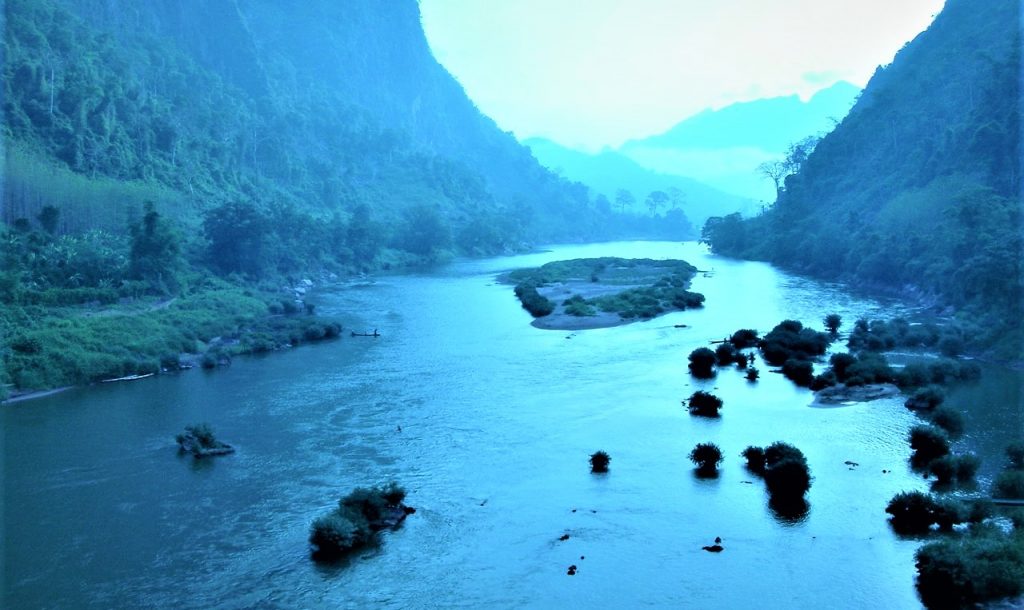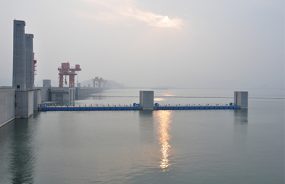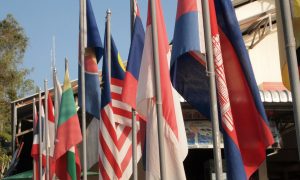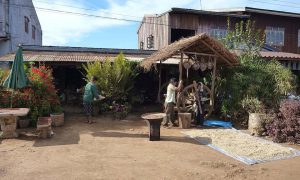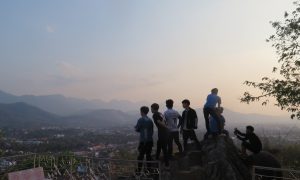Can we consider economic and financial ruptures, in addition to (or as an outcome of) nature-society ruptures? Along with a number of other countries who have embarked upon infrastructure and resource mega-projects under China’s Belt & Road Initiative, the Southeast Asian country of Laos is now experiencing sovereign debt distress. This has been unexpected for a country that enjoyed 7.5% average annual GDP growth from 2004-2018. How specifically has Laos found itself in such a financial predicament, what does it have to do with the country’s large investments in hydro-power and railway infrastructure?
Our 2021 paper published in Asia & the Pacific Policy Studies attempted to shed light on this question. We placed major resource and infrastructure lending from China at the centre of the story.
To recap, sovereign debt dynamics exacted a steep cost on the Lao economy in 2021. Laos’ sovereign rating with Moody’s sits at a “Caa2” with a negative outlook, with Fitch similarly at CCC, both firmly within the sub-prime / speculative category. Lao public debt reached $13.3 billion (72% of GDP in 2020), while debt servicing costs were at an alarming 52% of public sector revenues in 2021. With an average of US $1.3 billion in debt repayments coming due each year between 2021-25, and foreign currency reserves around that same level, the Bank of Laos has had to scramble to roll over maturing debt, even as this becomes more difficult with credit downgrades.
Commentators have focused on the $5.9 billion Lao-China Railway project in the Government of Laos’ (GoL) debt conundrum. However Laos’ contribution to this project may be relatively contained. The GoL injected US$250 million in equity financing from the national budget over 5 years, and secured a $480 million low interest loan from China’s Export-Import Bank for the remainder. While there may be future contingent liabilities if the project is unprofitable, the railway itself (which started operations in December) does not seem to be the most important current driver of Laos’ elevated debt burden.
Our analysis focused more squarely on a key state-owned enterprise—Electricite du Laos. Over the last decade, aided by Chinese lending, EdL has amassed a very significant debt load, reportedly around US$5 billion, with potential further contingent liabilities. In particular we examined EdL-backed hydro-power projects targetting the domestic energy market and national electricity grid expansion as a key source of debt vulnerability.
The first key point is that EdL’s power demand forecasts overshot by up to 50% of the wet season reserve margin. From 2011-2015 EdL signed a large number of Power Purchase Agreements with investors, and then from 2016 developed a series of major dam projects targeting the domestic market. However major new industrial projects and SEZs have either been delayed or have not fully materialized, leaving expensive hydro-electric facilities sitting idle.
Second, we document how EdL signed “take-or-pay” power purchase agreements (PPAs) with numerous Independent Power Producers. EdL extended contractual guarantees that they would serve as the electricity offtaker, whether or not there was demand for the power output. While take-or-pay contracts are common in the industry, by signing so many of these deals EdL exposed itself to financial risk through contingent liabilities. In short, EdL is in way over its head with PPAs, many with Chinese investors, and this overcapacity is set to persist for years into the future.

“PowerChina’s Nam Ou 1 Dam, Pak Ou District” Credit: Soytavanh Mienmany, 2018.
A third issue is Laos’ unfinished domestic transmission grid, which means that excess domestic power capacity, for example as produced from the $2.7 billion Nam Ou Cascade of 7 dams in northern Laos, cannot currently be re-routed to Vientiane Capital, the major load centre. The Nam Ou Cascade Phases 1 and 2, completed in 2015 and 2021, and led by PowerChina, involves loans from China Development Bank, and turnkey Engineering-Procurement-Construction (EPC) contracts with Sino-Hydro, under the auspices of the Belt and Road Initiative. While EdL holds only a 15% equity share in the Nam Ou Cascade, there are indications that the “take or pay” provisions extended to PowerChina has required EdL to reduce power generation from some of their own fully state-owned dams in order to avoid contract penalties with PowerChina. The prevalent use of EPC contracts in other China- linked electricity infrastructure, which recycle China policy bank loans back to Chinese construction enterprises, has also led to inflated cost structures for different power sector projects in Laos.
A fourth point relates to seasonal supply-demand swings. In Laos’ hot-dry season, hydro-power facilities operate at reduced capacity, while domestic electricity demand peaks, especially driven by increased air conditioning usage. Because of the unfinished domestic transmission grid, during this season EdL is often required to import electricity from Thailand. Yet the price Laos pays for those electricity imports has been double (US 11 cents/kWh) the initial export selling price (US 5-6 cents/kWh). Moves by EdL to increase domestic electricity tariffs to help cover this gap have been met with popular discontent amongst urban classes and from other ministries, and the GoL rescinded the price hikes.
Then there are the regional interests. Almost all of the Independent Power Producer dam projects targeting the Lao domestic market since 2016 have been funded by the China Development Bank. However Thailand and Vietnam have shown little interest in signing PPAs for projects in Laos in which their own construction firms or financial institutions are not involved. With EdL’s elevated debt burden, there was little scope to raise the estimated US $2 billion required to complete the domestic transmission grid and to thereby find new offtakers for surplus power.
Enter Laos’ newest state enterprise, Electricite du Laos Transmission Company (EdL-T), spun off from EdL, and a new financial backer, in the form of China Southern Power Grid Company (CSG). In September 2020, CSG agreed to a 90% shareholding in EdL-T, an apparent debt for equity swap, with the promise to complete the national high voltage power grid and turn around the fortunes of Laos’ teetering state-owned electricity champion. National and regional energy security issues lurk in the background to this deal.
The high price of Chinese hydropower
Lack of governance leads to costly social and environmental impacts.
More pieces may be yet to fall. The COVID crisis has hit Laos hard in 2021, with extended lockdowns in urban areas, and a collapse in tourism revenues. With large debt repayments coming due in the second half of 2021, the Bank of Laos has had difficulty raising new funds on the international bond market. A renminbi-denominated currency swap arrangement worth US $900 million extended by the People’s Bank of China in early 2021 has helped to patch some of cracks in the economic edifice. But the Lao kip is now coming under pressure, retesting lows against the US dollar set after in 2003. Poor performance of the kip means that US dollar denominated debts become more expensive to service, while local currency bonds become less attractive for investors. Meanwhile, government spending on health and education has fallen far behind debt servicing.

“The Dammed Nam Ou at Ngoi District”. Credit: Soytavanh Mienmany, 2018.
Overall, the Lao Government has pushed forward with an ambitious but risky hydro-power and infrastructure development scheme. The domestic component of Laos’ “Battery of Asia” ambitions has been funded to an important degree by China’s policy banks and involves Chinese construction firms. Our paper tracks the fallout from this debt-fueled infrastructure expansion in Laos, which has led to a credit crunch, pressure on state budgets, and the forced sale of state assets including the strategic EdL-T. Financial ruptures have thus flowed on from an aggressive dam-building spree in Laos.
Critical observers point to the larger problem whereby small developing countries must navigate vicious spirals of debt, credit downgrades and interest rate hikes during a financial shock, while large developed economies can seemingly engage in endless cycles of quantitative easing at low interest rates to navigate their way out of economic problems. This is part of the structural inequality of the global financial system. At the same time Laos has declined to participate in the World Bank Debt Service Suspension Initiative (DSSI), preferring to engage first with bilateral negotiations with China.
In Laos and in the Mekong region, it has been riverside communities and peasant farmers who have shouldered much of the cost of resource-led development, experiencing widespread dislocation, resettlement and sharp environmental impacts. Rural people displaced by dams are now joined by the urbanites struggling with inflation in household staples during a sharp economic downturn.
Debt problems continue to ricochet through the Lao economy. It is hoped the economy can rebound in 2022, supported by new electricity export deals, and new investment and tourism linkages facilitated by the Lao-China Railway. We can also see how, under a financialised resource investment regime, repairing the financial damage from nature-society ruptures requires ever more extractive investment. At the end of 2021, the GoL found itself in an unexpected financial corner, while many displaced rural communities and the urban poor are going underwater.
 Facebook
Facebook  Twitter
Twitter  Soundcloud
Soundcloud  Youtube
Youtube  Rss
Rss 